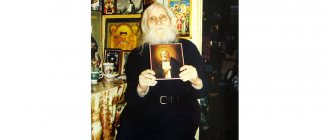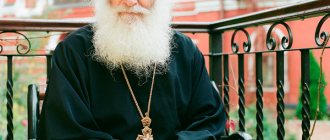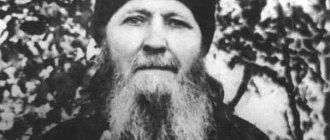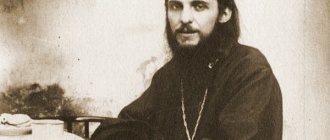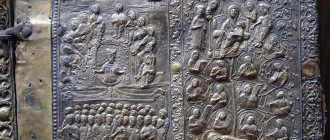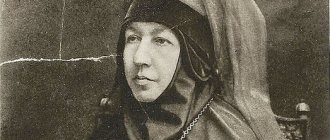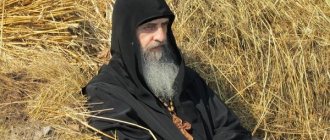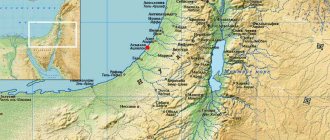Archpriest Georgy Breev
Born in Moscow into an unbelieving family. His father Pavel (d. 1971) was from the Tula province, graduated from a parochial school, but after arriving in Moscow in 1935 he joined the All-Union Communist Party (Bolsheviks). His mother was born into a peasant family in the Ryazan province. After arriving in Moscow, she met Pavel Breev, who was widowed after the death of his first wife and had two sons.
George came to faith on his own and was baptized at the age of 18. An example for him was the Golikov family of believers, whom they knew well. Yuri Breev talked with the Golikov children Vyacheslav and Natalya, his future bride. Natalya’s brother Vyacheslav Golikov subsequently graduated from the seminary and theological academy and took monastic vows. Now he is Abbot Pitirim, a monk of the Holy Trinity Lavra of St. Sergius.
Soon after his baptism, Yuri Breev decided to become a priest. After his conscription service, he decided to enter the seminary.
In 1960, he entered the Moscow Theological Seminary and Academy. His spiritual father since 1962 was schema-abbot Savva (Ostapenko) from the Pskov-Pechersky Monastery. While studying at the Trinity-Sergius Lavra, he became friends with another spiritual child of Father Savva, Rafail (Berestov). I wanted to become a monk, but my confessor, Father Savva, blessed me to marry. Then, in his penultimate year at the academy, he proposed to his fiancee Natalya Golikova, and they got married.
Through schema-abbot Savva, Father George and his wife met Archpriest Vladimir Ivanov, who served in Berlin and taught at the University of Munich. Other close friends of the Breev family were the artist Mikhail Shvartsman and a researcher at the Institute of Oriental Studies Vsevolod Sementsov, who became the godfather of his son.
In 1968, he graduated from the seminary, and on December 17, 1967, he was ordained to the rank of priest. Soon after his ordination, he was sent to the clergy of the Moscow Church of the Nativity of John the Baptist on Presnya, where he was the third priest in the temple. He served there for 22 years. Finishing the course with a dissertation “The Psychology of Sin according to the Works of Macarius of Egypt,” he was awarded the title of Candidate of Theology for it.
In 1990, Father George received the blessing of Patriarch Alexy II to restore and organize the parish of the Church of the Icon of the Mother of God “Life-Giving Spring” in Tsaritsyn. He was appointed rector of this temple. Under his leadership, the temple was restored, regular services began there, a Sunday school was created, and educational and publishing activities began. In 1998, restoration work in the temple was completed, and on the basis of the Sunday school, with the blessing of Father George, the Life-Giving Spring school was created.
In 1998, he was also appointed rector of the Church of the Nativity of the Blessed Virgin Mary in Krylatskoye. Under the leadership of Father George, the small temple in Krylatskoye was expanded while maintaining its architecture. A separate building for the baptismal church and Sunday school was built. Spiritual education for children, youth and adults was organized, and charitable work was organized on a regular basis. Since 1998, with the blessing of Archpriest Georgy Breev, festivals of Slavic literature and culture have been held for schoolchildren, for which Father Georgy received special gratitude from Patriarch Kirill.
Mitred Archpriest Georgy Breev was one of the oldest Moscow clergy and diocesan confessors of Moscow; twice a year he confessed to the entire Moscow clergy and accepted henchman confessions before ordination.
Died on April 29, 2021. He was buried at the altar of the Church of the Nativity of the Blessed Virgin Mary in Krylatskoye, where he served for 22 years.
While serving in the army, George has to endure a lot because of his faith.
Soon Georgy goes to serve in the army, where he talks about one incident that happened to him:
“...An army day begins with physical exercises. I'm taking off my tunic.
The foreman yells at the top of his lungs: “Cross! Cross!"…
He rips off my chain with a cross. A flurry of obscene shouts follows...
Immediately, three more soldiers were found to have crosses sewn into their hats and tunics.
Lecturers on atheism urgently begin anti-religious study.
I'm waiting for the outcome. They don't call anywhere.
A young political instructor with the rank of captain comes up in the evening, hands me a torn cross, and asks: “Is this yours? Do you believe?" - “Yes, I am a believer.” - “Take your cross and wear it: no one has the right to forbid you to wear it.
Just remember one condition forever: you do not have the right to impose your religious beliefs on any soldier, otherwise you will have difficulties.”
No one clearly expressed a bad attitude towards me; on the contrary, secretly some of the officers asked questions...”
But it didn’t end there; soon another incident occurred: “...The Holy Gospel lying in the nightstand provoked open discontent of one major, who was responsible for the life of the soldiers.
Many times he demanded that I destroy “this book.”
Unable to disobey the decree, after answering him “I obey!” I did not take any action, for which I was sent to another place of service, to an outpost.
My arrival was preceded by a rumor that “a sectarian is arriving at the outpost, nothing can convince him, don’t fall under his influence...”
Georgy Breev
priest
After graduating from the army, Georgy entered the Moscow Theological Seminary and Theological Academy in 1960. Schema-abbot Savva becomes his spiritual father.
See also the article Father Gennady from Otradny
Schema-abbot Savva is a clergyman, spiritual writer, and resident of the Pskov-Pechersk Monastery. He is revered in the Orthodox community as an elder. Spiritual father of Georgy Breev
While he was studying at the Trinity-Sergius Lavra, he became friends with one of Savva’s spiritual children, Raphael.
Raphael, clergyman of the church, hieroschemamonk, tonsure of the Holy Trinity-Sergius Lavra, widely known critic of ecumenism. Friend of Georgy Breev
George soon wanted to become a monk, but Father Savva blessed George for marriage.
And soon, in his penultimate year at the academy, he married Natalya Mikhailovna, the younger sister of a friend, whom he had known since childhood.
Father Georgy Breev with Mother Natalia Breeva, his wife. They have two children
About Prut, Novorossiysk and Kursk
— I know that not only those who fell in the Crimean War are buried here.
— From the graves of our necropolis you can study the history of the Russian fleet. Let us remember the heroes of the First World War. The crew of the minelayer "Prut" from the German battle cruiser "Goben" was offered to surrender; instead, our sailors raised the ceremonial silk St. Andrew's flag over the burning and sinking ship, preferring death to captivity. Newspapers later wrote about “Prut” as about the Sevastopol “Varyag”.
In the cemetery lie participants in Sinop, other naval battles with the Turks, heroes of the Caucasian and Persian wars, the Civil and Great Patriotic Wars. And nearby are the graves of the guys who died in 1955 on the cruiser Novorossiysk. The horror is that many of them could have been saved. They drowned fifty meters from the shore, near the Hospital Wall. More than seven hundred people—young, smart, healthy, strong—lost their lives. Yes, there was an explosion on board, but why did it take so long to make the decision to tow it? The admirals at headquarters continued to confer when the sailors were already suffocating in the battened-down cockpits. After all, the alarm team played.
It was necessary to tow the battleship to the shore, clamp it with tugs - and all the guys would remain alive and get out of the metal trap. Instead - a painful death from suffocation or decompression sickness.
The tragedy of the Novorossiysk and then the Komsomolets submarine are bitter and important lessons that must be remembered.
— The same words can be said about the death of the nuclear cruiser Kursk.
— Seventeen Sevastopol residents served there. The first crew member raised to the surface and the last one found are buried here. That's how fate decreed.
A man came to our church and prayed for his son who had gone missing on the Kursk. The bodies of most of the sailors were discovered, identified and buried, but one officer could not be found. The boat had already been dragged into the dock and was about to be cut into parts to establish the cause of the accident.
And so the inconsolable father once came up to me and said: “Father, where is the justice? I raised my son in love for the Motherland, he grew up honest, smart, handsome, and now I can’t even come to his grave.” I answered: “Pray to St. Nicholas, he will definitely help.”
After some time, the man prayed: “Where is your God? Why won’t he return his son?” And he pronounced every word with such, you know, pain, resentment. I again tried to console as best I could.
And then the remains were found in the far compartment of the Kursk. The officer was literally twisted into metal by the blast wave... The ashes were brought to Sevastopol and betrayed to their native land. And the hero’s father was convinced that his prayers were heard.
So it turned out that we have the alpha and omega "Kursk". First raised and last found...
There is also a symbolic stone in the cemetery in memory of all the submarine warriors who died in different geographical locations of the World Ocean.
Veterans came to me with a request: “Father, there are guys who, along with their boats, are still at the bottom. We want to erect an obelisk with their names and coordinates of the accident sites. For their relatives - wives, children, grandchildren. So that they can come to the cemetery, even for a conditional burial.” I supported: “It’s a righteous deed, I think the Lord will bless it.” And now we have a place where they constantly bring flowers...
"Son of the Regiment." Photo: From personal archive
Father George wrote a lot of literature - books and articles
One of Father George’s famous books is called “Rejoice.”
In the book, the priest talks about Christian holidays, the difficulties and joys of human existence, ways to solve “insoluble” problems, and recalls his life. Therefore, the book will be interesting to people of all ages.
The book includes conversations and interviews with Archpriest Georgy Breev, which were published on the pages of the “Family Orthodox Newspaper”
Many Orthodox articles have also been written, such as: “Memories of a spiritual son”, “The Triumph of Orthodoxy”, “On the revered icons of the Mother of God”.
In 2013, a documentary film was made in which Father George starred, entitled “The Flavians.” The purpose of this film is to show, using the example of real clergy, that there are “good shepherds” in our lives - the Flavian Fathers.
It’s easy to get to Father George; he is always open to communication with parishioners
Many people want to communicate personally with Father George. The first thing many people ask is how to get to him? Indeed, even now, for many years, thousands of pilgrims have been drawn to Father George, seeking blessings and advice.
The Church of the Nativity of the Blessed Virgin Mary in Krylatskoe belongs to the St. George Deanery of the Western Vicariate of the Moscow Diocese. Father George serves here
Father George receives everyone in the church after the evening or morning liturgy.
Father George receives not only adults, but also sick children suffering from various diseases. He gives his blessing and also helps young children to believe in Divine power.
See also the article How to get to Elder Ily Nozdrin in Peredelkino
You can get to Father George at the address: 121614, Moscow, Krylatskie Hills street, territory of the park-reserve.
You can get there using the following route:
- from metro station "Krylatskoye" - 15 minutes on foot;
- from metro station “Molodezhnaya” - bus 732, 829 to the stop “Church”;
- from metro station "Kuntsevskaya" - bus 733;
- from metro station "Polezhaevskaya" - bus. 271;
- from Sokol metro station - trolleybus 19 to Krylatskoye metro station, then 15 minutes on foot.
To find out any details, or clarify any information you are interested in, you can call: (495)413-4566.
Or write by email:
Pilgrimage buses also run to the temple; you can sign up for such a trip by phone or email.
By leaving a comment, you accept the user agreement
About the service
- Are you supposed to be a special forces soldier?
- Without “seemingly.” Separate special motorized police battalion in Krivoy Rog.
He graduated from the sergeant school in Donetsk. We were called the “wild hundred”, they left us to restore order where it was hot. Let’s say there was an accident in a mine, people died, so “specialists” were sent to prevent mass protests against the Soviet regime. We helped the police if they couldn’t cope.
Krivoy Rog had to be kept in check. The city is specific: for a population of 750 thousand there are 250 thousand former prisoners. And we had empty horns of Kalashnikov assault rifles; the cartridges were carried in a box; they were not allowed to load them with live ammunition, so as not to accidentally shoot anyone. Usually we sat on the bus and waited to see if a serious provocation would begin. I remember they were launching the 9th blast furnace, a Komsomol construction project. The people went wild, walked around widely... And we kept an eye on it so that nothing would happen.
At the end of my service, for the capture of a dangerous criminal, I received the title of excellent student of the Soviet Army and a valuable gift - a red alarm clock.
I shot well. From a pistol and a machine gun. After lights out, I trained, specially holding a metal bed frame at shoulder level for several minutes, so that my hand wouldn’t shake. You put a penny on the Makarov front sight, make a click at idle, and the coin should not fall...
Officers and warrant officers loved to compete with me in accuracy. They were stuck that the sergeant hit more accurately. Usually bets were made on condensed milk, sugar and butter. As a rule, I came out the winner. The guys themselves asked to join my department: we were already fed well, and I also got additional food. The prize money was divided among everyone...
— Have you been offered to continue serving in the authorities?
— You could go to the police, to the security forces. But I didn't see myself in this capacity.
He returned to Sevastopol and went fishing. I went to sea on a felucca. Firstly, the salary is good. If the winter season is successful, you may not have to work for at least six months.
But, in fact, I was waiting for the moment to enter the seminary. It was necessary to send the documents to the admissions committee in such a way that the KGB would not intercept them. I didn’t send it by mail, I sent it through a trusted person.
While I was collecting medical certificates, I said that I wanted to study to become a sailor. In fact, if I had not made it to the seminary, I would have gone to Murmansk to become a higher naval officer and try my luck in the navigating department. So you're talking to a would-be sea captain.
- Really?
— A boy who grew up by the sea cannot help but dream of scarlet sails.
But I still have eight hikes. Even if not on the captain's bridge, but as a priest.
-Where did you go?
— To the Mediterranean Sea, Syria, participated in the landing in Pristina. This is a different story...
Childhood. Secular education
Yuri Serafimovich Kochetkov was born on October 5, 1950. He was baptized with the name George when he was ten years old. I believe, according to Fr. George, he found while still at school: he came to Christianity through the art of the Renaissance. He studied well and also willingly shared what he knew, so while still in the 7th grade, he already took his classmates on excursions to the Kremlin temples. During his school years, George read the Holy Scriptures for the first time.
In 1972, the future priest Georgy Kochetkov graduated from the general economics department of the Institute of National Economy. G.V. Plekhanov. Then he enters graduate school, but does not defend his thesis because enters the Leningrad Theological Academy (LDA). At the same time, the full seminar course is taken externally (28 exams).
Criticism. Persecution
Father George was repeatedly subjected to various criticisms, as well as slander and persecution, for his active church activities. Father George and the Transfiguration Brotherhood were falsely accused of sectarianism, heresies, beating a priest, disobedience to the hierarchy, neo-renovationism and modernism. In some dioceses, members of the Brotherhood were groundlessly excommunicated from communion, they tried to ban the announcement, they demanded that they “repent” and renounce their spiritual father, they organized persecution in the media, and they refused to participate in church events without explanation.
Many accusations fell away on their own over time. What the Brotherhood and Fr. George was accused (catechesis, community life, regular communion), is now becoming a general church norm, or at least recognized by many as such. However, there are people who continue to circulate baseless accusations.
Preobrazhenskoye Brotherhood
One of the main areas of Father George’s ministry is related to the gathering of communities and brotherhoods. Since the founding of the Preobrazhensky Commonwealth of Small Orthodox Brotherhoods (Preobrazhensky, 1990), Father Georgy Kochetkov has been its spiritual trustee.
The Transfiguration Brotherhood is currently one of the largest informal spiritual movements in the Russian Orthodox Church. In 2015, documentary director Alexander Gutman made a film about brotherhood dedicated to the 25th anniversary of PSMB.
A detailed biography of priest Georgy Kochetkov can be read on his personal website: www.ogkochetkov.ru
Priest Georgy Kochetkov's Facebook account is here.
Awards
Church:
- Gaiter (1941)
- Order of the Pskov Spiritual Mission (1942)
- Medal of the Russian Orthodox Church St. Sergius of Radonezh (1975)
- Order of the Russian Orthodox Church St. Sergius of Radonezh (1978)
- Order of the Russian Orthodox Church of Prince Daniil of Moscow (1980)
- Order of the Latvian Orthodox Church sschmch. John (Pommer) of Riga
- miter
- Order of the Russian Orthodox Church of St. blgv. Prince Vladimir
- Order of the Russian Orthodox Church St. Seraphim of Sarov III degree (2005)
Secular:
- honorary citizen of the city of Ogre
